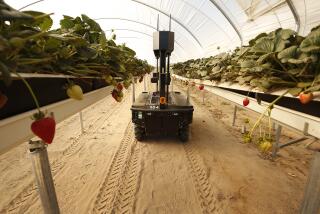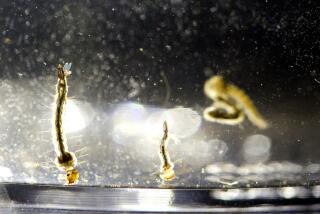When Life Gives You Tomatoes . . .
DAVIS, Calif. â It was touted three years ago as a miracle tomato perfected by the wonders of gene splicing--plump, sweet, juicy and slow to rot.
But the Flavr-Savr--the first genetically engineered food to win Food and Drug Administration approval--proved too costly to produce and therefore shriveled on the vine, commercially speaking. For a time, it seemed that Calgene Inc., the Davis biotechnology pioneer that developed the product and then wallowed in tomato-red ink, would die with it.
Look again. Rescued by a cash infusion from giant Monsanto Co., which in May completed its purchase of the company, Calgene is now regarded as the world leader in the emerging--and potentially hot--arena of genetically modified vegetable oils.
Calgeneâs products, led by a canola seed oil enhanced by a gene from the California bay laurel tree, are designed to replace higher-cost tropical or synthetic counterparts in a vast array of goods, from detergents to face creams to chocolate-coated ice cream bars.
Given Monsantoâs deep pockets, well-honed marketing talents and oft-reiterated commitment to futuristic food and personal-care products, Calgene finds itself free to pursue the type of trailblazing research that helped the company put agricultural biotech on the map years ago. Though no longer independent, Calgene also is no longer lashed to the whims of Wall Street.
âWhat Monsanto wants Calgene to be is an innovation engine,â Lloyd M. Kunimoto, Calgene president, said recently in his sparely decorated office at Calgeneâs Davis headquarters. âWeâll provide food companies and personal-care product manufacturers with better and more cost-effective raw materials.â
Kunimoto, who grew up in Hawaii and received a bachelorâs degree from Stanford in math and physics, plans to be on hand in St. Louis today, when Monsanto shareholders are scheduled to approve the companyâs long-planned split into two pieces: the old-line chemicals business and the life sciences unit, of which Calgene is a part. Itâs likely that the Monsanto name will remain with the life sciences operations, which also include the G.D. Searle pharmaceutical company, Roundup weed killer and Roundup Ready crops, and NutraSweet Kelco, which markets food ingredients.
Food ingredients have always interested Monsanto, founded in St. Louis as a saccharin maker in 1901. The company has lately put an emphasis on bioengineered nutritional products. One plan is to use Calgeneâs technology to develop lower-fat, lower-calorie frying and baking fats that could lengthen the shelf life of breads and other products while making them more healthful.
Since 1995, Calgene has been marketing the first of its specialty oils, a âlaurate canola,â to food manufacturers. Sold as Laurical, it contains a high proportion of lauric acid, a fatty acid found in tropical oils. (Fatty acids make margarine and shortening hard so that they can be used for baking, frying and spreading. They also help give soaps and detergents their foaming properties.)
Among early customers is Procter & Gamble, which has bought millions of pounds of the substance for use in soaps and detergents.
Two other products are in the pipeline: a âstearate canola,â containing stearic acid, which will be used as a potentially more cost-effective and healthful liquid shortening for big baking operations, and a âmedium-chainâ fatty acid, for use in medical nutrition (such as intravenous and infant formulas) and, potentially, in consumer products such as high-energy snacks and beverages and better-tasting low-calorie potato chips. Those products are at least two years away.
Moreover, Kunimoto said, much of Calgeneâs research is transferable to soybean seeds, in which Monsanto has invested heavily.
Soybeans could emerge as a highly economical way to produce such oils in larger quantities to compete with commodity oil products. Calgene also is experimenting with modifying canola to give it the properties of fish oils, which facilitate brain and eye development in infants and also are thought to help in reducing cholesterol.
âCalgene is a key piece in both our ag biotech and food and nutrition strategies,â said Robb Fraley, co-president of Monsantoâs agricultural sector.
Calgeneâs work with oils was, in fact, the magnet that drew Monsanto.
âIf you look at the biotech big picture, one of the big pots of gold is changing oil content,â said Sano M. Shimoda, president of BioScience Securities Inc., an Orinda, Calif., investment bank focusing solely on agriculture biotechnology.
Jeff Cianci, an investment analyst with Bear, Stearns & Co. in New York, projects that âoils will be big in the next decade.â
Calgene, he added, is âleading the pack,â given its impressive patents and Monsantoâs distribution clout. However, Cianci noted that the products are still in their infancy and that âthe market must be developed.â
Still, Calgene is confident that oils wonât prove as slippery a business as fresh produce.
Kunimoto expects the company to be selling 100 million to 200 million pounds of its oils annually by 2000. At maturity, he said, sales should reach âseveral hundred million pounds,â with a targeted price of 50 cents a pound, half the current cost of, say, cocoa butter from Africa.
âThis is not a billion-dollar product,â he said. âThere are very few NutraSweets [Monsantoâs artificial sweetener, with about $800 million in yearly sales] out there. But there can be a handful of $100- to $200-million products.â
DuPont, another chemical giant, is also attempting to modify oils but is going after markets for large-volume commodity oils.
For specialty oils, Calgeneâs main rivals appear to be smaller labs, which Kunimoto views as potential sources for useful technology.
Founded in 1980, Calgene dedicated itself to using agricultural biotech to improve the nutritional aspects of foods. In March 1996, after the Flavr-Savr debacle, Monsanto bought a 49.9% equity stake in Calgene, upping its ownership later that year to 54.6%. Last January, Monsanto proposed a buyout of all remaining stock at $7.25 a share--a purchase that ultimately went through at $8 a share, after Calgene shareholders complained that they were getting a raw deal.
They have the tomato to blame for what many viewed as an unsatisfactory return.
By attempting to be the first to market a genetically engineered tomato, Calgene took risk upon risk, said Desmond Jolly, director of UC Davisâ Small Farms Center.
For starters, the company failed to develop tomato varieties that could be grown in adequate quantities in different regions. It also erred in assuming that existing equipment, geared for handling baseball-hard tomatoes picked green, would work for its product, picked ripe and marketed under the MacGregor brand name. It also ran up against peopleâs skepticism about an unknown quantity for which they had to pay a premium.
âPeople were scared of genetic engineering,â Jolly said. âIt was a turnoff, and they didnât want it rushing into their food supply.â
Led by Chief Executive Roger Salquist, the company became a bombastic champion of biotech. Gaining approval from the FDA to sell the Flavr-Savr took several laborious years that exhausted company resources and personnel. Both Salquist and Kunimoto acknowledge that the companyâs biggest mistake was trying to push the product too far too fast.
âFresh produce is a brutal industry, period, let alone adding genetic engineering and branding,â said Salquist, who left as CEO a year ago and is now a San Francisco merchant banker specializing in life science investments. Marketing the Flavr-Savr, he said, âwas like Robert E. Lee at Gettysburg. By the time the troops got to Pickettâs Charge, they were all worn out.â
Nonetheless, Calgene garnered credit from the industry for its path-breaking work in educating regulators about genetically engineered produce.
Meanwhile, the dynamics and economics of the tomato industry have been altered by longer-shelf-life Israeli varieties that are being grown with tremendous per-acre yields in Mexico. Monsanto is reluctant to declare the Flavr-Savr dead, noting that its Gargiulo produce subsidiary is still studying the issue. But Calgeneâs connection with the product is all but over, aside from some lingering research.
Although Calgene three years ago put most of its chips on the tomato, the companyâs scientists were also amassing a portfolio of patents on other technologies, including oils, naturally colored cottons and cotton seed that can tolerate a potent herbicide and resist certain insects.
The key to modifying canola oil was inserting another plantâs gene to change the carbon composition of the oilâs fatty acid. The modified oils help produce the lather in soap, lend nondairy whipped topping its ability to retain air and give cocoa butter substitutes a chocolate-like melting point (so that it melts in the mouth, not in the hand).
Canola was a logical crop because it can be grown in more temperate climates than can coconut and palm trees.
Canola is grown in Canada, northern Europe and the United States, providing the opportunity for a more dependable supply.
Down the road from headquarters, Calgene greenhouses hold row after row of canola plants in various stages of development. Bar codes help researchers keep tabs on the plants and their tiny black, oil-bearing seeds.
A looming challenge for Kunimoto will be to zero in on a new Davis site for a headquarters and laboratory complex, expected to cost $5 million or so and to be completed by late 1998. Such plans indicate Calgeneâs worth to Monsanto--and vice versa.
âWhatever we would have been able to do as an independent company,â Kunimoto said, âis quite pale in comparison.â
More to Read
Inside the business of entertainment
The Wide Shot brings you news, analysis and insights on everything from streaming wars to production â and what it all means for the future.
You may occasionally receive promotional content from the Los Angeles Times.











